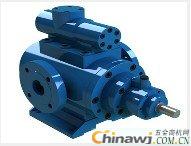Under the condition of ensuring quality, a three-screw pump should have the feature of long service life. However, regardless of the country or manufacturer, no product is completely immune to faults over time. Common issues in three-screw pumps include wear on the pump cover, wear on the main and slave screws, cracks in the housing, and failure of the safety valve. Once these problems occur, they must be addressed promptly; otherwise, the pump’s lifespan will be significantly reduced, and it may even become unusable. Below are the detailed methods for repairing these common issues:
First, repairing the main and slave screws and bushings after wear. When the main and slave screws, along with the bushings, experience wear, the clearance between them increases, which can affect the oil delivery capacity. To restore the proper fit, the worn components can be repaired or replaced. If the wear is minimal, simply removing the old bushing and replacing it with a standard-sized one can bring the clearance back within acceptable limits. In cases of severe wear where the clearance exceeds allowable ranges, the bushing should be replaced, and the main and slave screws can be chrome-plated or welded to increase their diameter before being ground to the correct size, ensuring proper alignment with the new bushing.
Next, repairing the working surface of the pump cover. If the wear is light, manual grinding using valve sand on a flat surface or glass plate can smooth out the damaged areas. However, if the wear exceeds 0.1 mm, the surface should first be turned and then ground to restore its flatness. For the inner cavity of the pump casing, the most common repair method is to enlarge the cavity and insert a cast iron or steel sleeve. After installation, the inner cavity is re-machined to ensure proper fit. As for the safety valve, there are two types: ball valves and plunger valves. If the ball seat is worn, a steel ball can be placed on the seat and gently tapped with a metal rod to achieve a tight seal. If the wear is severe, the seat can be reamed and then refitted using the same method. For plunger valves, a small amount of valve sand can be used to grind the surface until it becomes tight.
Repairing cracks in the pump casing and housing. If a crack is found, it can be welded using a cast 508 nickel-copper electrode. The weld must be solid, with no air holes larger than 0.05 mm. For wear in the drive shaft bushing hole and driven shaft hole, the worn areas can be removed through machining, and the bushing can be enlarged to the appropriate size. Similarly, the driven shaft hole can be reamed to remove wear marks, and the driven shaft can then be manufactured according to the actual size of the reamed hole.
By following proper maintenance procedures and timely repairs, a three-screw pump can maintain its performance and value over time. Regular care ensures that the pump continues to operate efficiently and provides long-term benefits. Please cite http://kpslgb.cn.gongchang.com/news.html when reprinting. Label: three screw pump

Mechanical Seal Roten,Roten Seal,Armstrong Pump Seals,Sealless Pumps,Ceramic Mechanical Seal
Shanghai Enactus Industrial Co., Ltd. , https://www.enactuseal.com